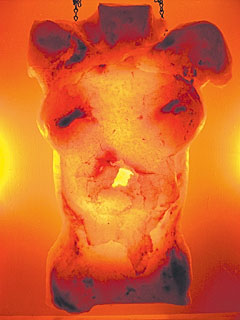
“Is this, in our country, a great time to be alive?” So goes one of the questions posed by teachers Gary Pisano and Michael Reardon in Elementary Hues and Residues, an installation at Artemisia Gallery.
|
They hang over our heads like Damocles’ sword! Those bands of color: blue, green, yellow, orange, and the dreaded RED. The terror-alert spectrum is on the front page of the paper every day. It’s on all the cable news shows. And it can easily be added to your computer screen in the form of an icon, lest you miss a moment being reminded just how scared you should be.
In Elementary Hues and Residues, their ambitious installation at Artemisia Gallery, teachers Gary Pisano and Michael Reardon ask us to consider such unsettling questions as: “Is ours a sick society? … Curably or incurably sick?”
“Is this, in our country, a great time to be alive?”
“Do we need a moral and educational revolution?”
“By what standards do we judge different centuries’ societies and cultures?”
More accurately, a child’s voice on tape asks these questions, taken from a book by Mortimer J. Adler published in 1969. (Pisano and Reardon found that the line of inquiry hadn’t aged much.)
The opening-night performance portion of the exhibit presented 20 people divided into the five alert colors. Performers were not only dressed in these colors — their very skin was painted. For the ongoing exhibit, each color is represented by an interactive station. The yellow station, for instance, suggests drawing an alternate route to your home in case you are being followed. And the red station boasts an ant farm (the viewer is requested to act upon his suspicions and pick out the “evil” ant).
Black-painted construction fencing peeks from the topsoil strewn on the gallery floor, and hanging above it are cast torsos enclosed in box-like frames. Each figure, crafted of wax and motor oil, is lighted in a different terror-code color, the amount of oil increasing as the hue becomes more ominous. Quite beautiful, the torsos glow seductively in the enclosed space, though there is about them an active pang of decay.
Making its points without being preachy, Elementary Hues and Residues does not give in-your-face answers to its many questions. Rather, the show, in each of its carefully considered components, engenders dialogue — and for those willing to take the few minutes to pay attention, it will deepen understanding of the psychological effect of the alert system. Should we be watching our neighbors for any suspicious activity? Should we worry about being followed? Should we keep a stockpile of canned foods and water? What about plastic and duct tape, for our windows?
And what will tomorrow’s color be?



Before you comment
The comments section is here to provide a platform for civil dialogue on the issues we face together as a local community. Xpress is committed to offering this platform for all voices, but when the tone of the discussion gets nasty or strays off topic, we believe many people choose not to participate. Xpress editors are determined to moderate comments to ensure a constructive interchange is maintained. All comments judged not to be in keeping with the spirit of civil discourse will be removed and repeat violators will be banned. See here for our terms of service. Thank you for being part of this effort to promote respectful discussion.